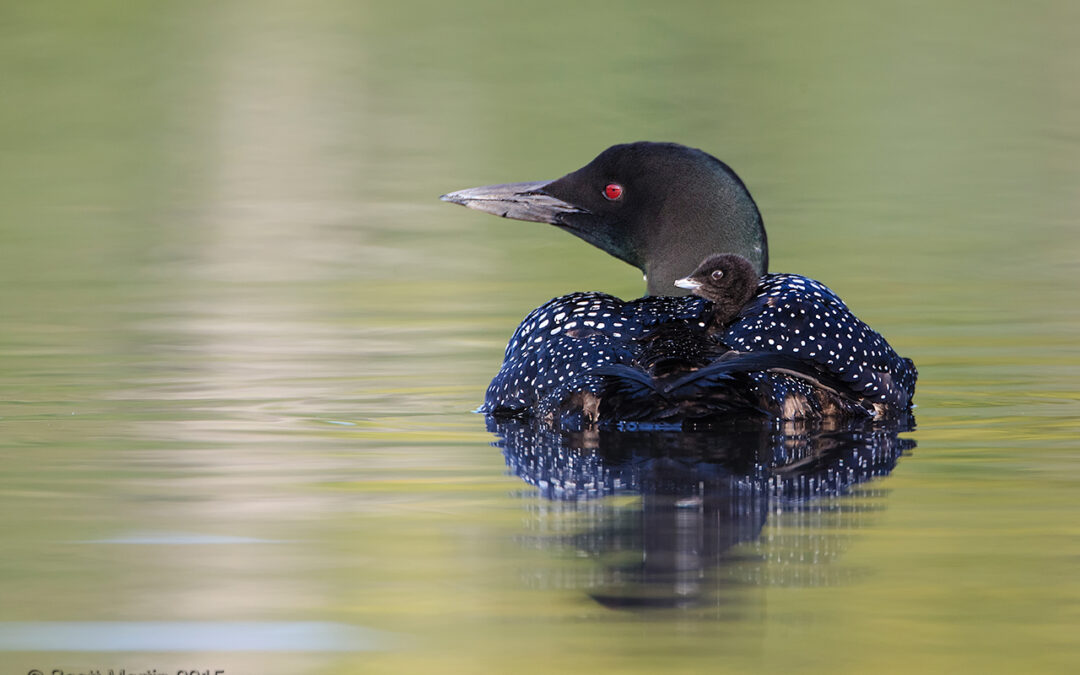
by Scott Martin Photography | Sep 15, 2015 | Birds, Blog, Loons, Shore Birds & Waterfowl
Well we find ourselves in the middle of September and realizing that another summer has slipped away seemly a little faster than the one that preceded it. For me also came the sad realization that there has not been a blog post on this website since May which certainly wasn’t by design. I will do my best to get caught up processing the images that have been taken over the past few months, starting with the Loons that Deb and I had the privilege of photographing in Algonquin Park in June of this year.
There is nothing ‘common’ about the Common Loon. One of our country’s favourite birds whose presence on our dollar coin provides its nickname; the Loonie. Deb and I have been following nesting Loons in Algonquin Provincial Park for a number of years now and this year it was a pleasure to time our trip perfectly to be able to capture some photographs while the babies were still small enough to enjoy riding on the parent’s back.
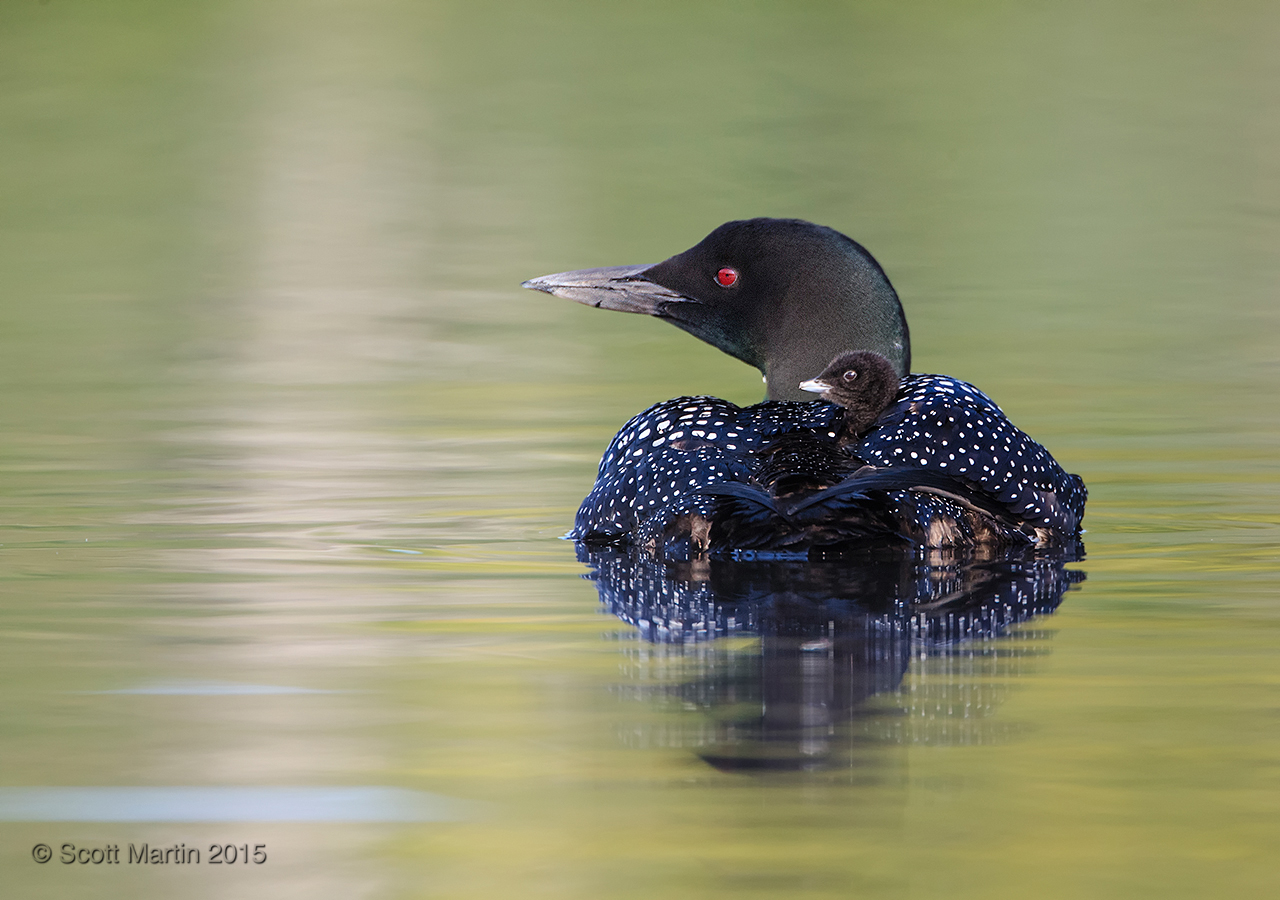
All of the images in this post were taken handheld from a canoe, providing a nice low angle of incidence which is appealing for bird photography.
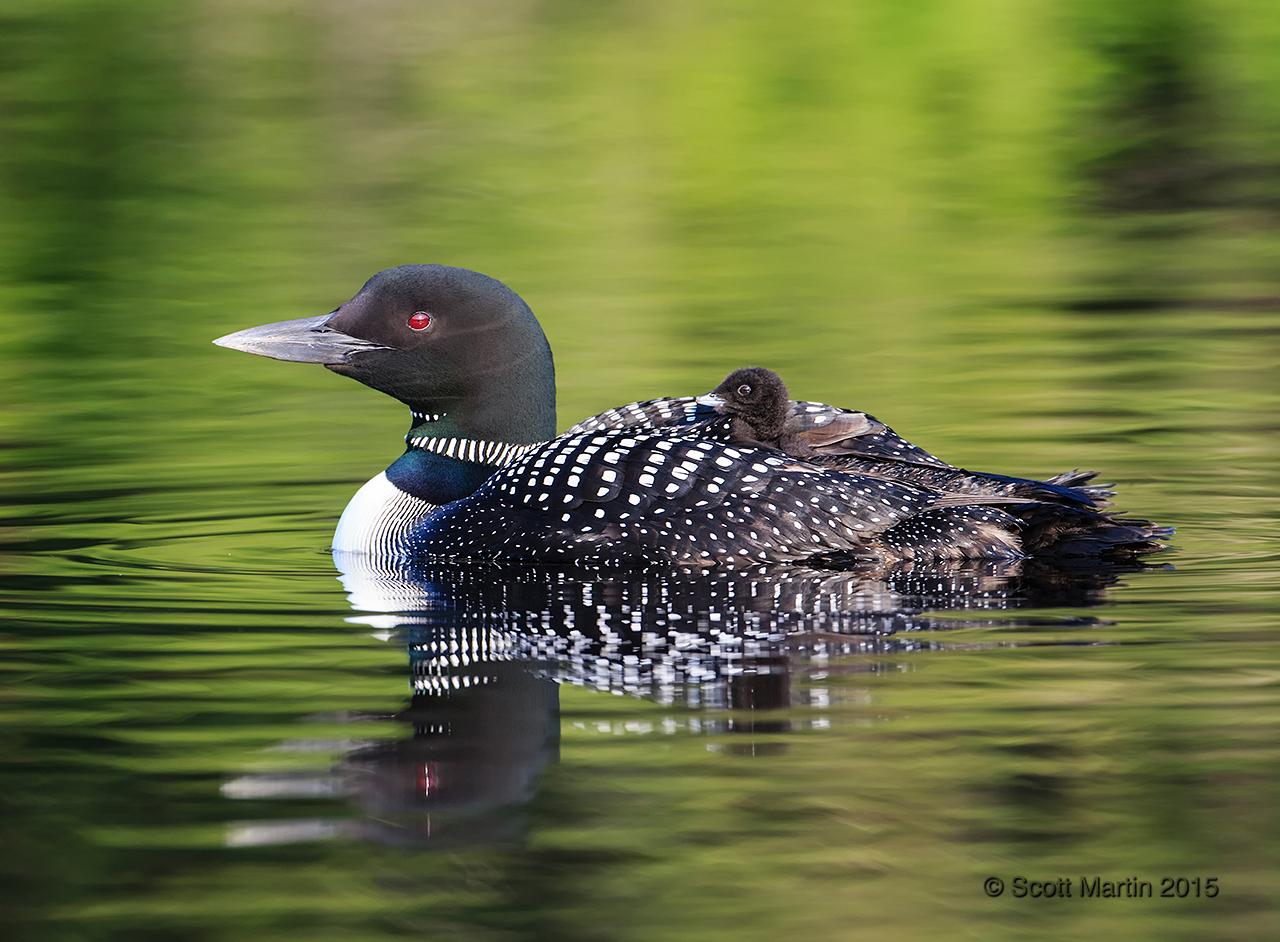
Early morning is the best light for photographing Loons with the low sun highlighting their deep red eyes and typically the waters are calm making for nice reflections. The green back ground is created by the reflection of the shoreline vegetation on the water and when possible it is always a good idea to position yourself to create different combinations of lighting on the bird and back ground colour. The effects can be dramatic. These next two images are of the same Loon with a very different look due to the back ground colour.
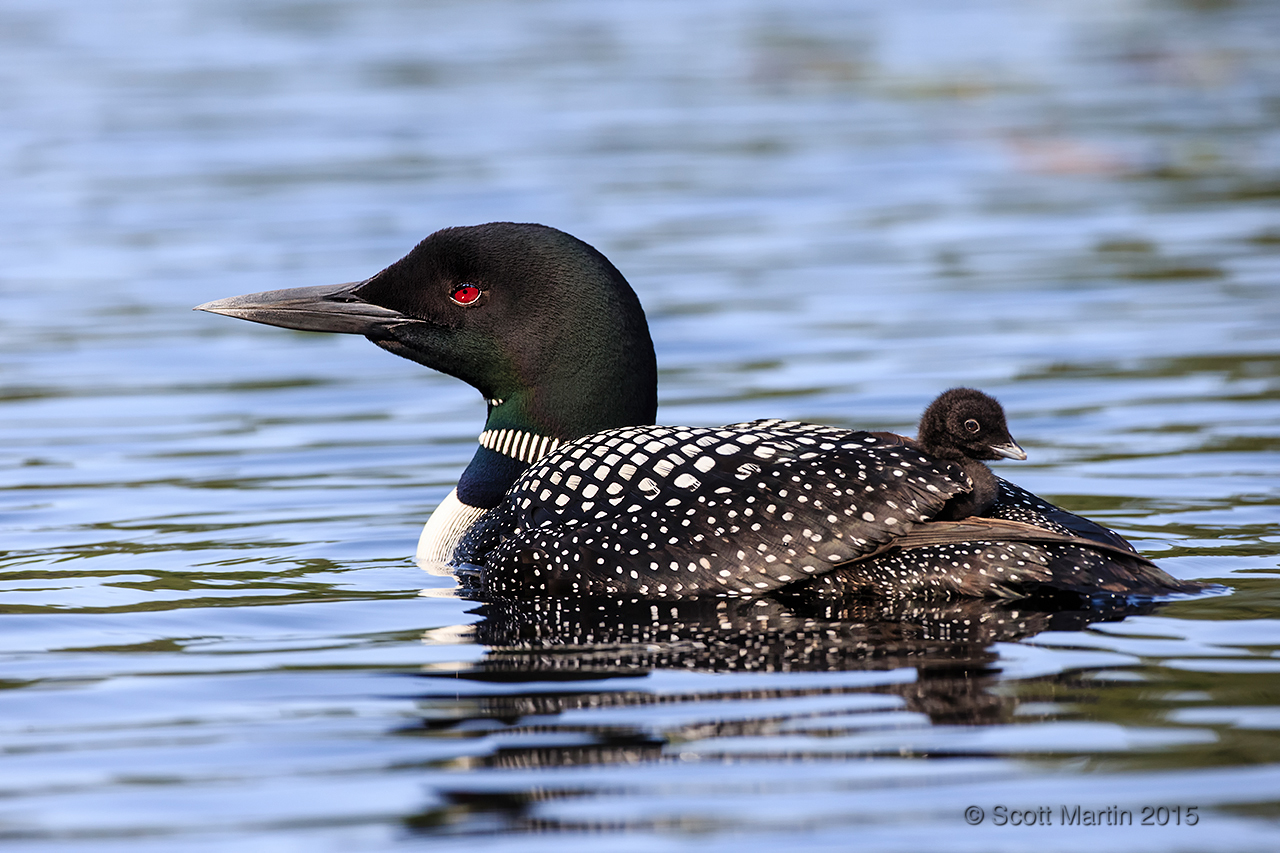
.

Common Loons are a pleasure to watch and hearing their distinctive calls is like no other bird. The following images are an attempt to capture the activities of these beautiful birds.
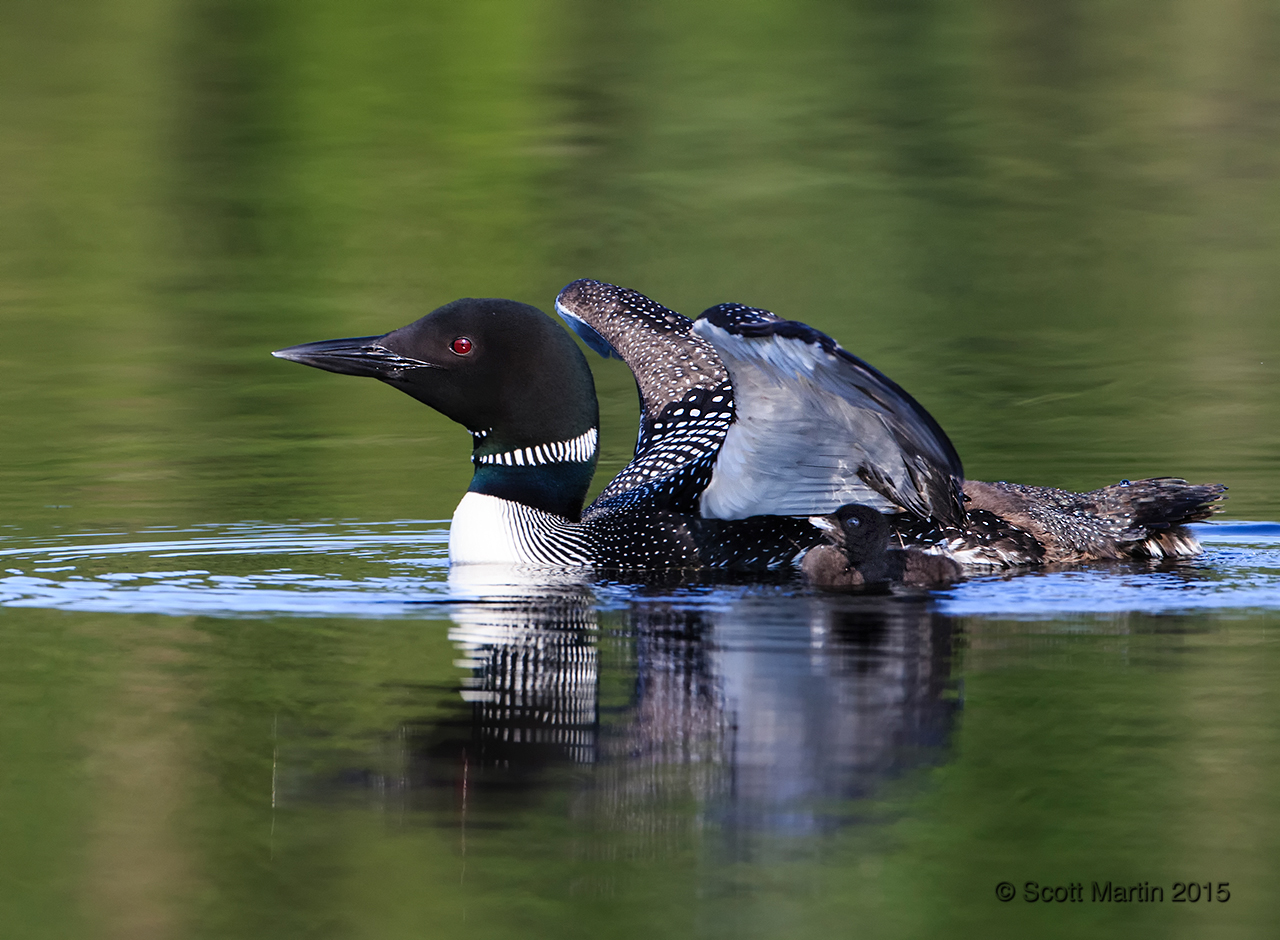
.
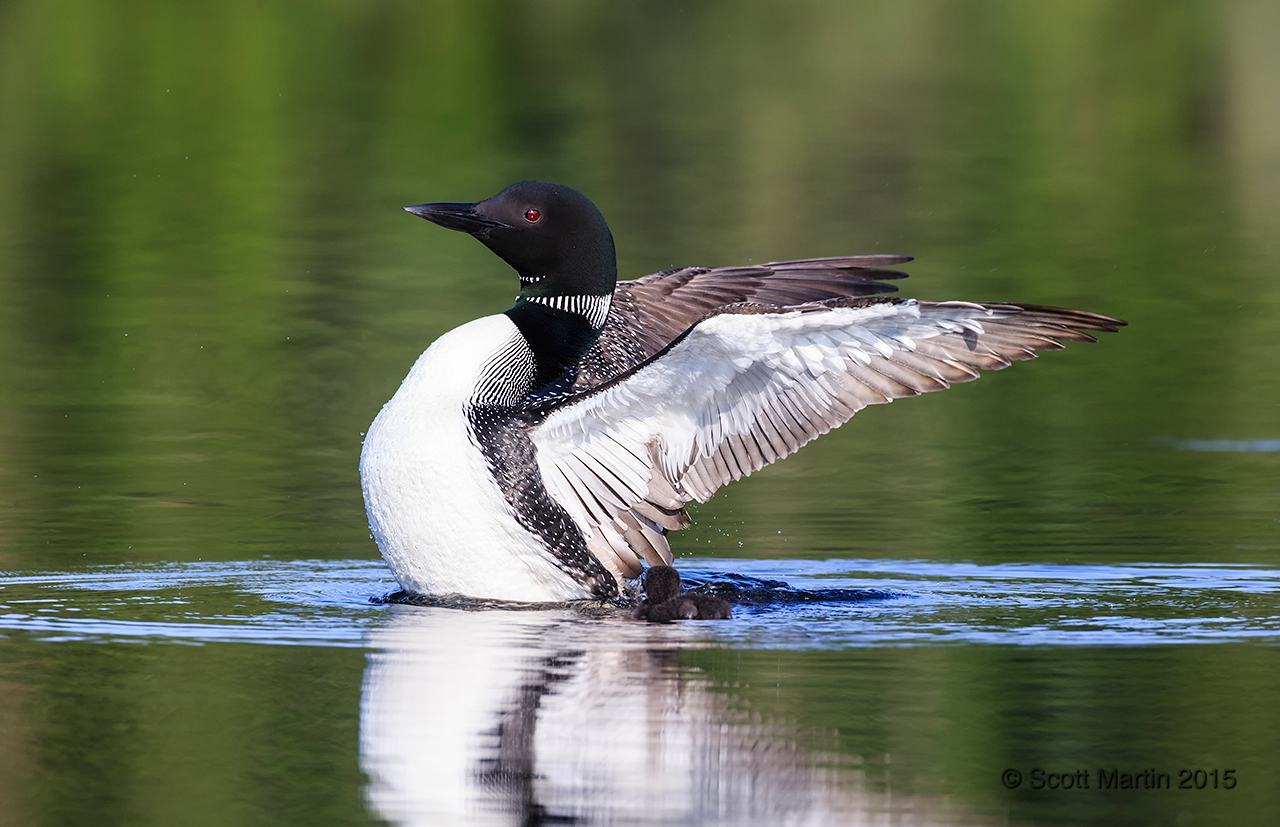
.
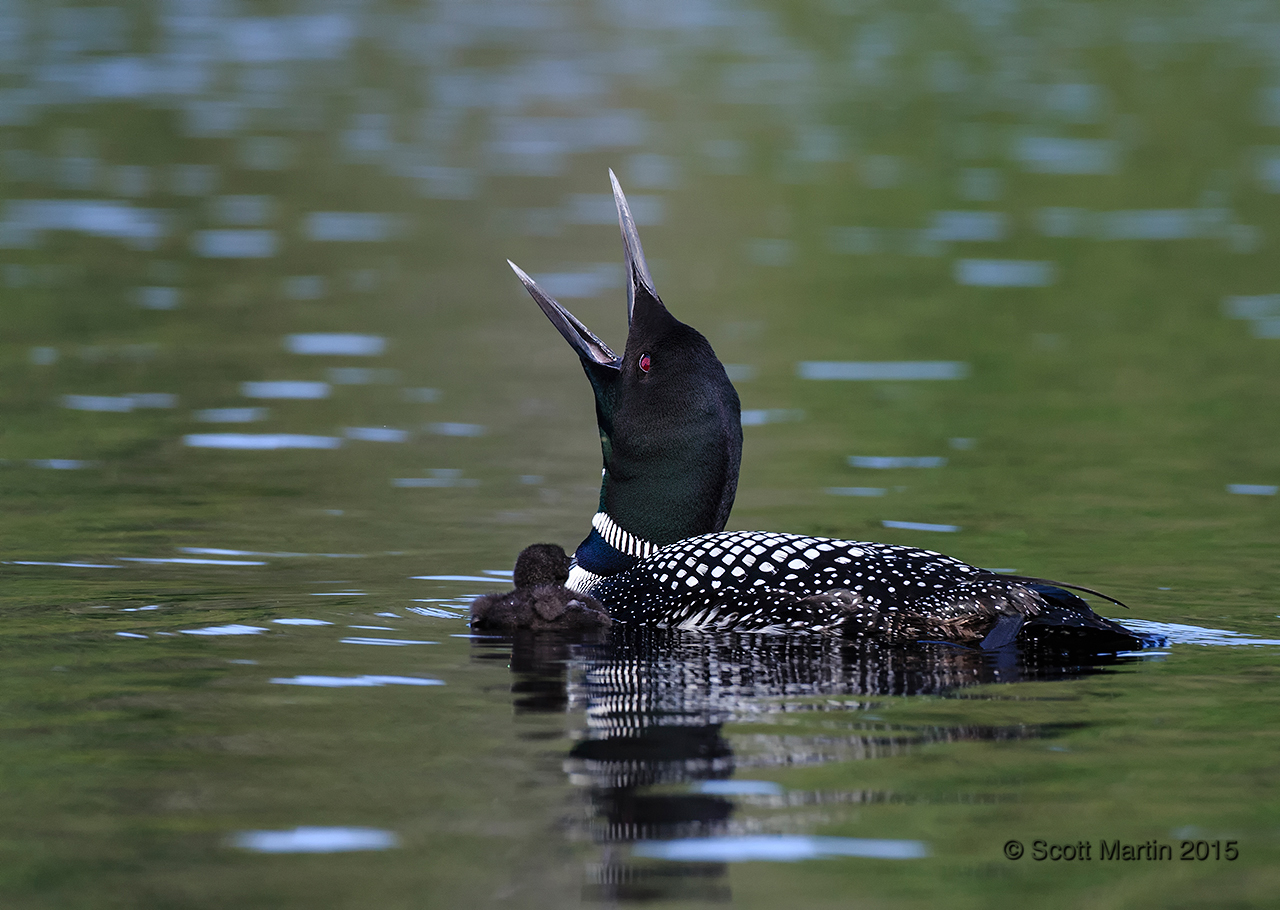
.
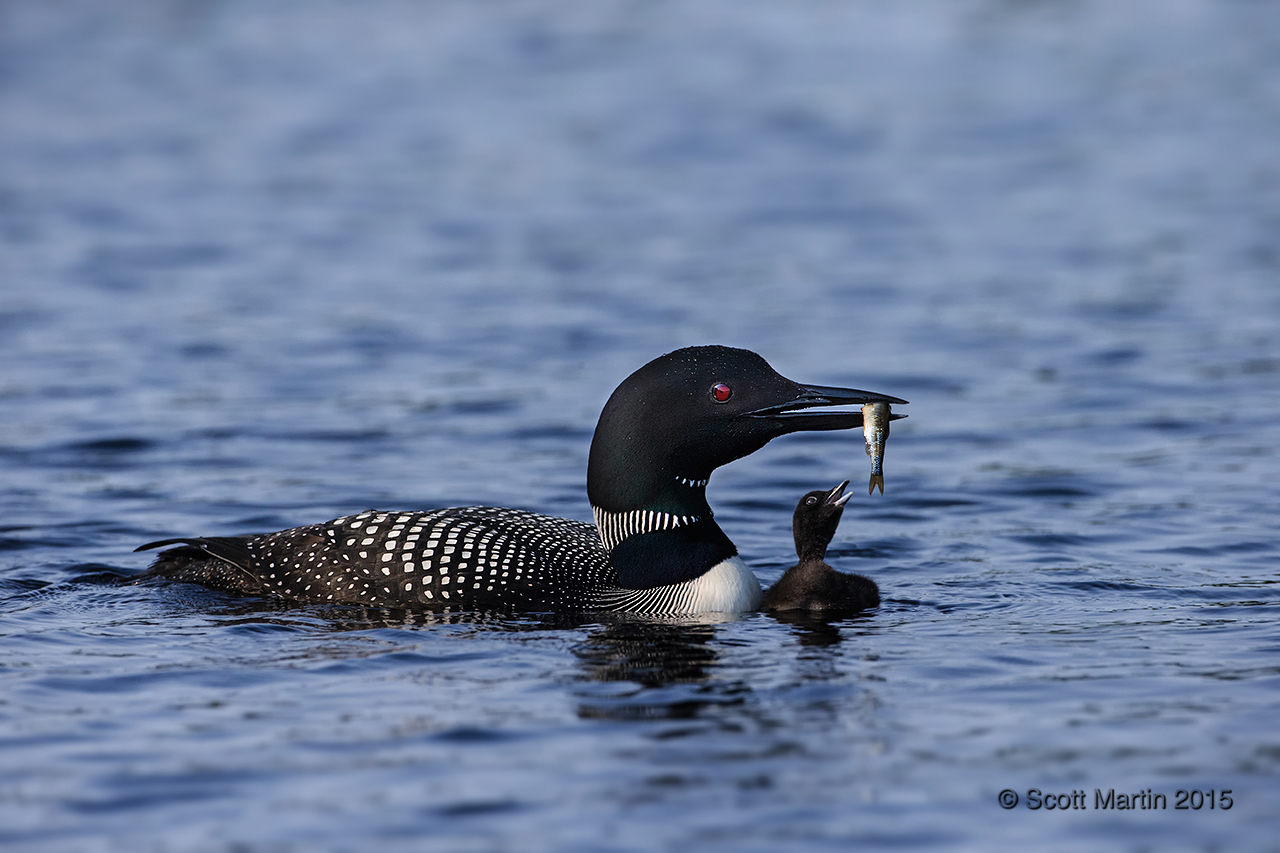
.
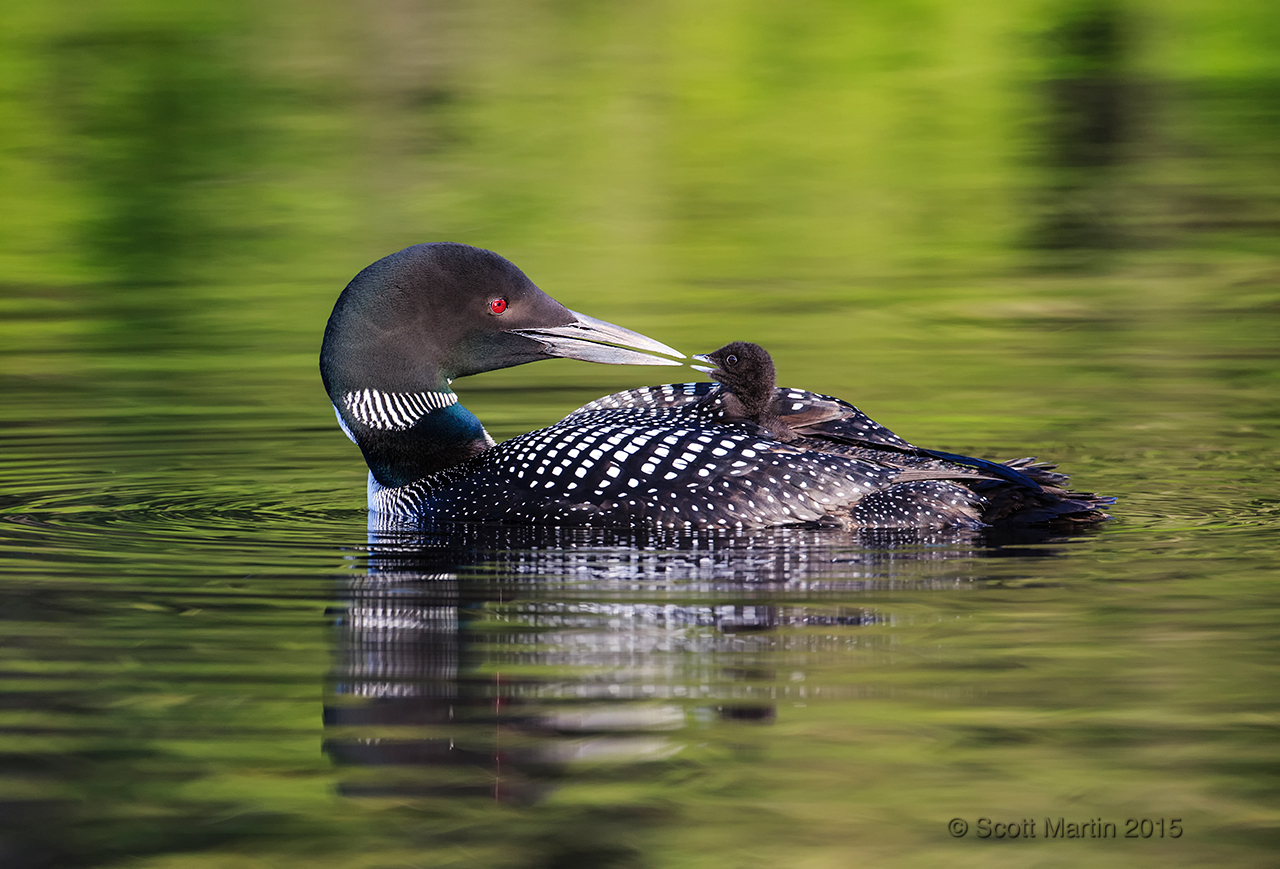
As hinted in the title of this post, this Loon photography excursion was also the first practice session with a new camera body; the Canon 1Dx. This particular body is design optimized for sports and wildlife photography or any activity where you are attempting to capture objects moving quickly through the field of view. It accomplishes this by having a very high frame rate. The 1Dx is capable of taking exposures at 12 frames per second in RAW format and 14 frames per second in JPEG format. This makes the camera ideal for photographing birds in flight and I was glad that a Loon obliged us with a fly by close to our canoe. Here are two in flight captures of the Loon taken with the 1Dx and Canon EF 500mm f4 IS lens, handheld from the canoe which is quite a challenge, however like anything, practicing enhances the results.
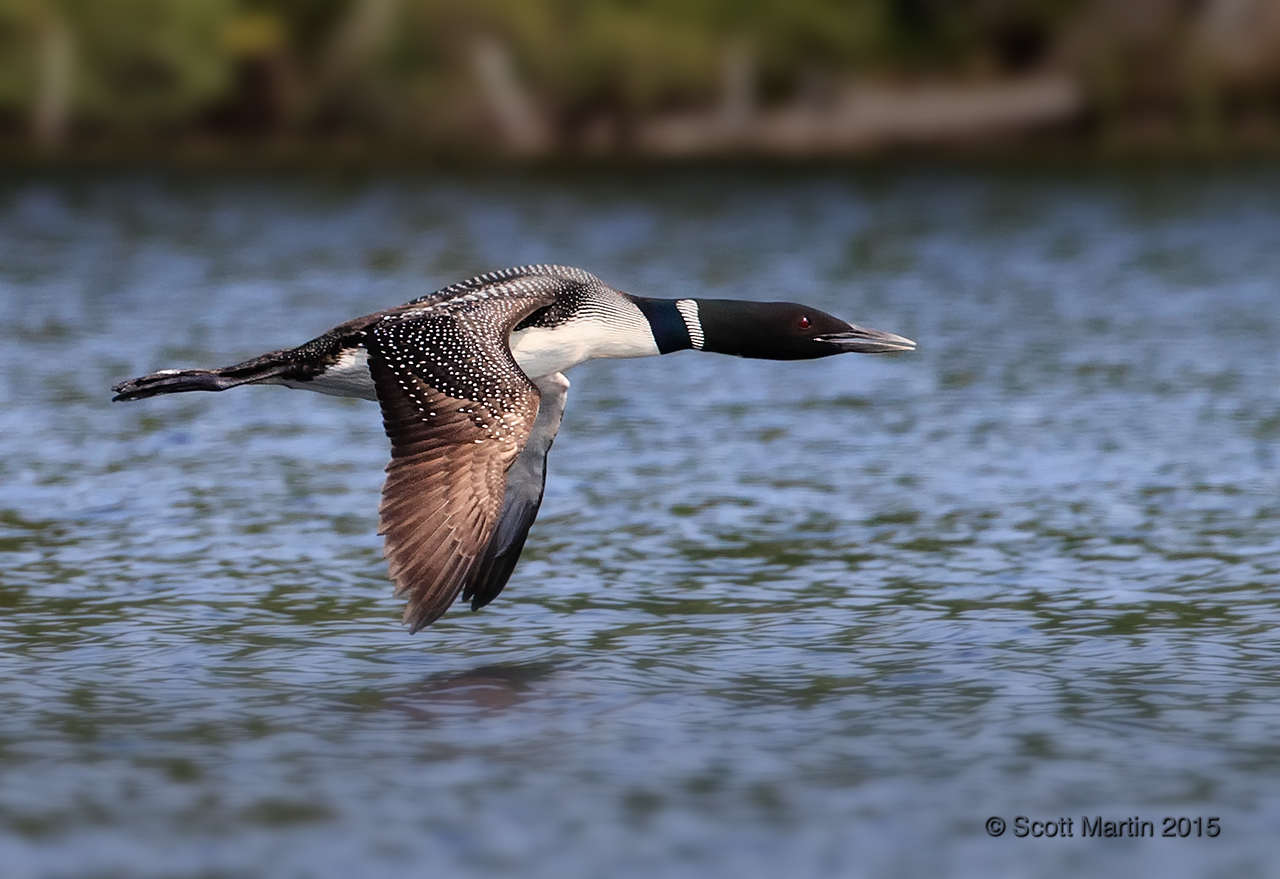
.
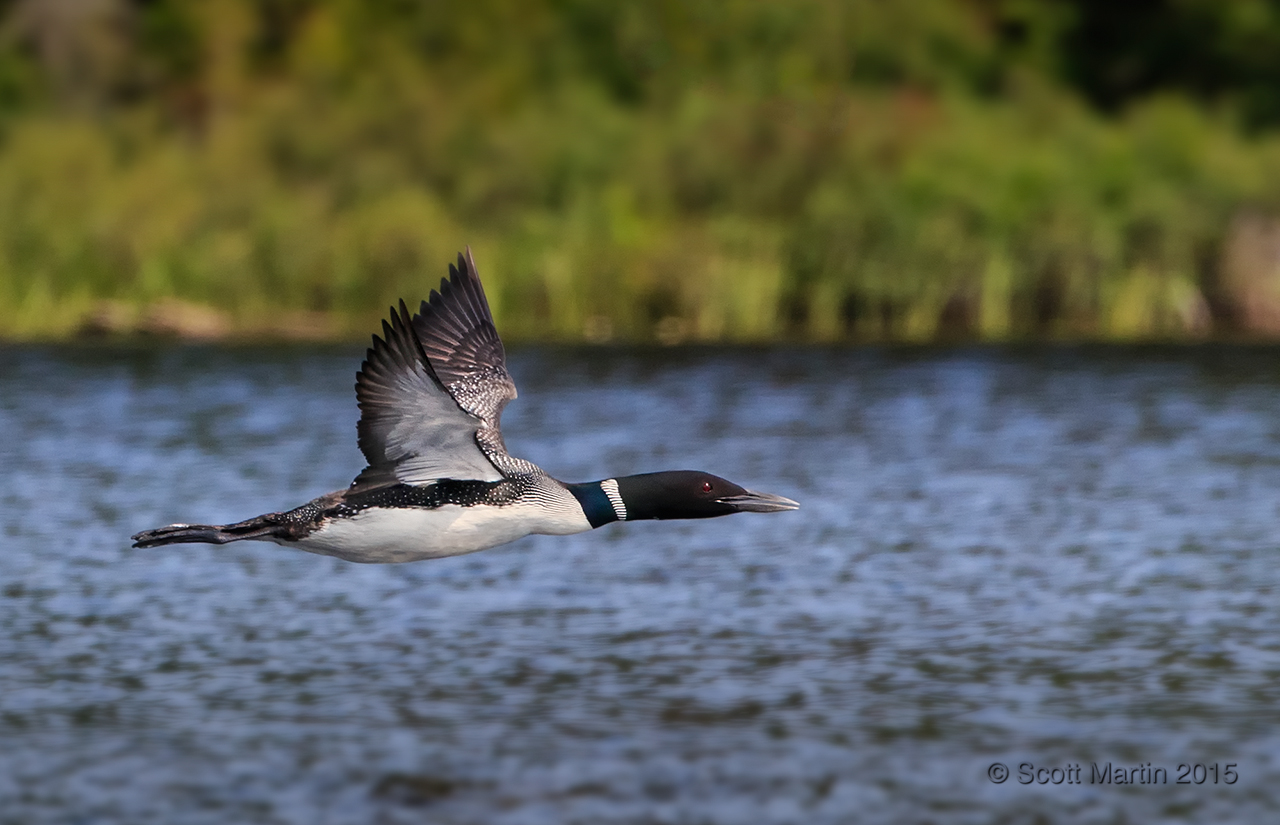
Now that I have upgraded to the new camera, my Canon 1D Mk III is up for sale and if any of you are looking for a great camera body and looking to move up to a professional grade body, this could be the perfect opportunity for you. It comes with all the original packaging and is looks just like it did when it was brand new. Send me an email if you are interested and I will send the details and pics of it. The 1D Mk III is a 10 frame per second, 10 megapixel camera.
Sometimes when you take a lot of pics you get some pleasant surprises when processing the images. This next image, and the last one in today’s post, is one of those shots and its become my favourite photograph from our morning with the Loons. The reason being, I didn’t notice the day old chick poking its head out from under the protective cover of mom or dad’s wing until seeing the image displayed on the monitor. I trust you enjoy it as well.
Peek-A-B00
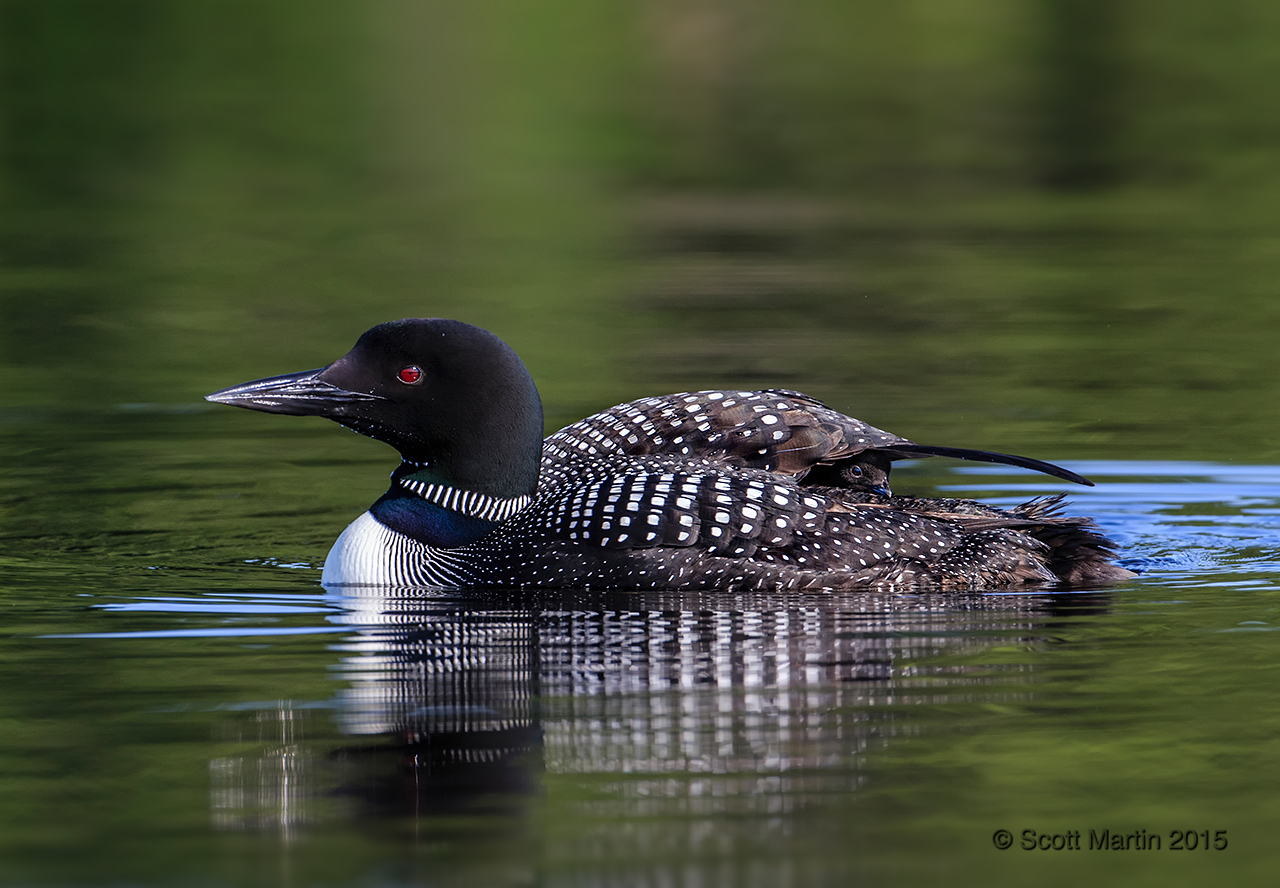
There are a number of other Loon images from our day in Algonquin Park posted in the Loons & Grebes Gallery as well as Loon photographs taken at other times.
Thanks for taking time to work through this post and as always your comments are welcomed.
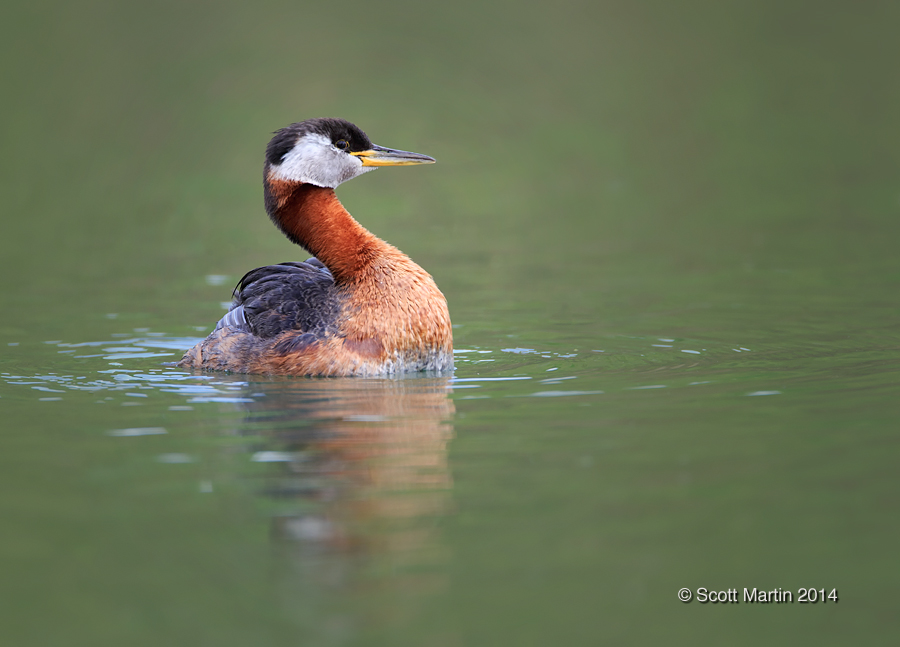
by Scott Martin Photography | Jul 14, 2014 | Birds, Blog, Loons, Shore Birds & Waterfowl, Wildlife
In North America there are seven species of Grebes, however this post will focus on the Red-necked Grebe, which is a medium to large sized bird that frequents fresh water marshes and lakes from the north-west (Alaska & the Yukon) extending southwards to Texas. It is rarely found east of Ontario.
The Red-necked Grebe is a rather nondescript grey bird during the winter months, however transforms into the beautiful bird in this post when it adopts its breeding plumage, including its red neck, white face and black crown with its characteristic tufts.

Grebes typically nest on floating beds of vegetation which allows for protection from the usual land based predators. Like Loons, Grebes are awkward taking flight and ‘run’ along the water for a long distance before acquiring the speed required to take flight. As a result of this you don’t often see Red-necked Grebes in flight other than during migration. Also similar to the Loon, the Grebe’s legs are positioned far back on its body making it very immobile on land but adept in the water. The Grebe dives when faced with a threat as opposed to taking flight. This next image show an adult on the floating nest (in breeding plumage both sexes appear the same so differentiation is very difficult, although the male is usually the heavier of the two sexes).
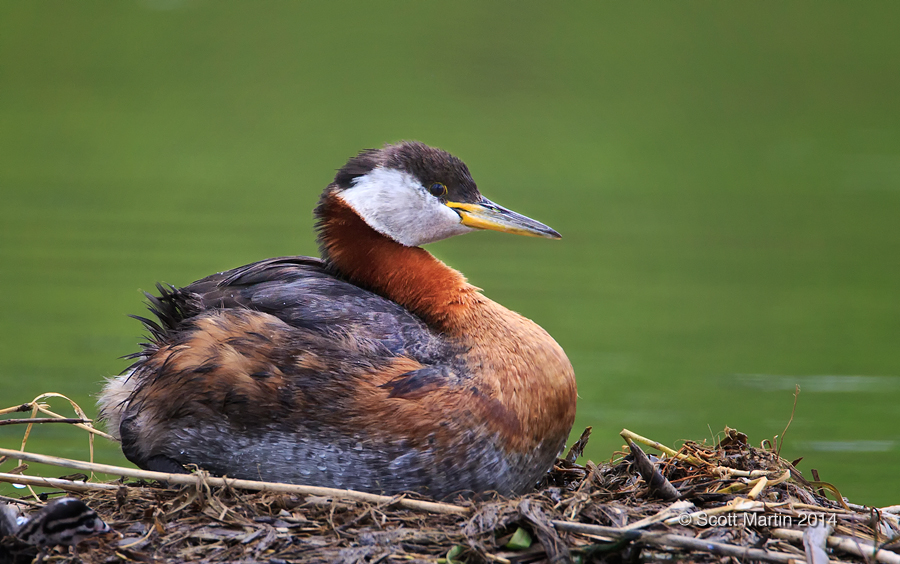
Red-necked Grebes lay two to six eggs which enjoy shared incubation for 20-23 days before hatching. This family had four young ones making for a busy time of feeding. The biggest threat to the young chicks are fish (particularly pike and muskie) and snapping turtles and for this reason, along with the desire to keep warm and comfortable, they spend the first few days of life snuggling on the backs of the parents. It is always a treat to see these young families and watch the young jostle with each other to get the favoured position on mom or dad’s back.

The choice position cuddled at the base of a parent’s neck is only available to one, but perhaps they take turns! Young birds grow very rapidly and Grebes are no exception, so the opportunity to see them on the backs of the parents only lasts for a few days. In just a few months they must be big enough and strong enough to migrate south for the winter. Interestingly, Grebes migrate mostly at night.
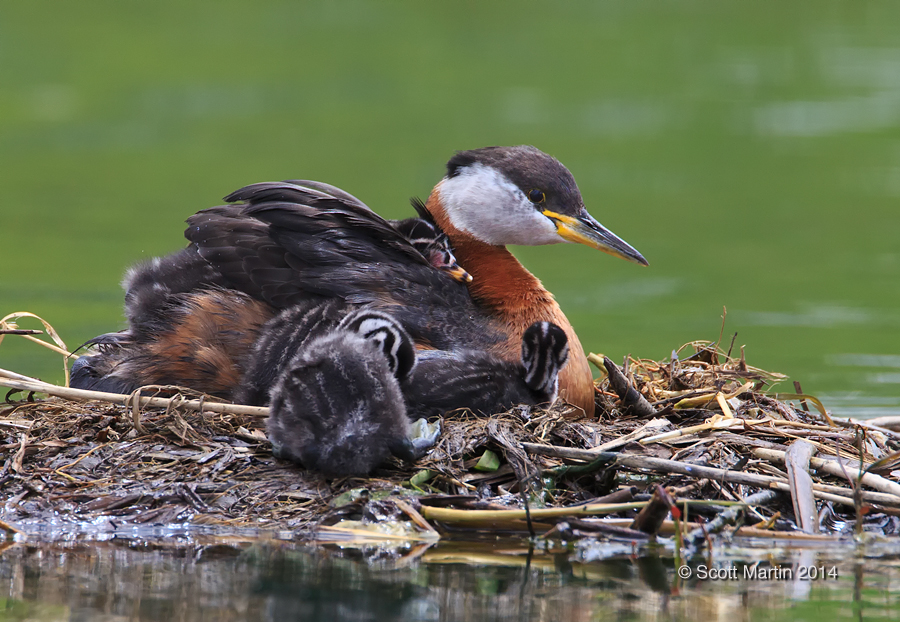
The little sentinel, learning to be a keen observer of the surroundings. Observational skill is essential for survival and although the Grebe reduces land based predator threats by nesting on the water, other birds (hawks and gulls) pose danger as do many other aquatic adversaries (fish, snakes & turtles). Grebes are typically very quiet however when threatened do make a series of loud and unusual screeches & squawks.
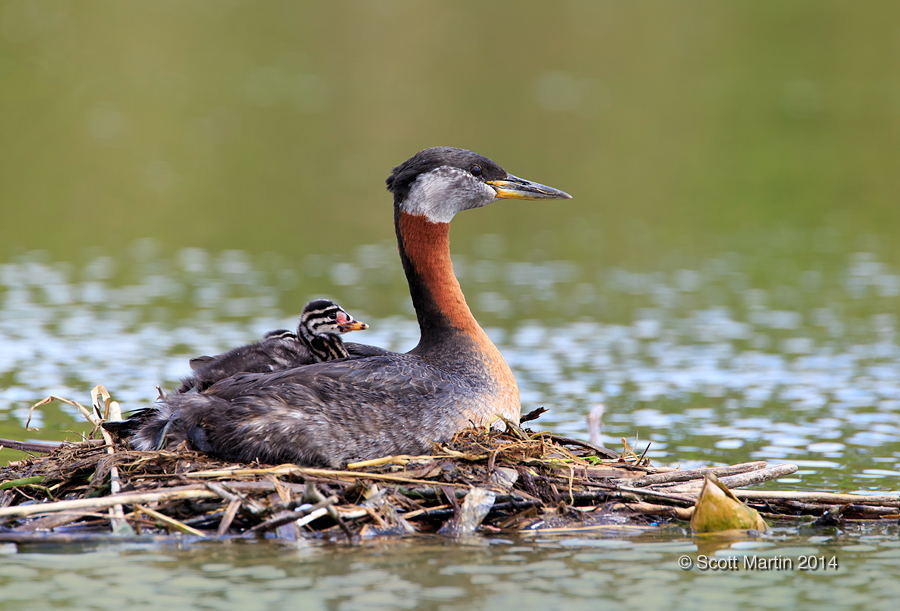
The chicks have very distinctive black and white banding patterns on their head and necks which give them a little zebra like appearance. This next shot captures the unique beauty of the young birds head.
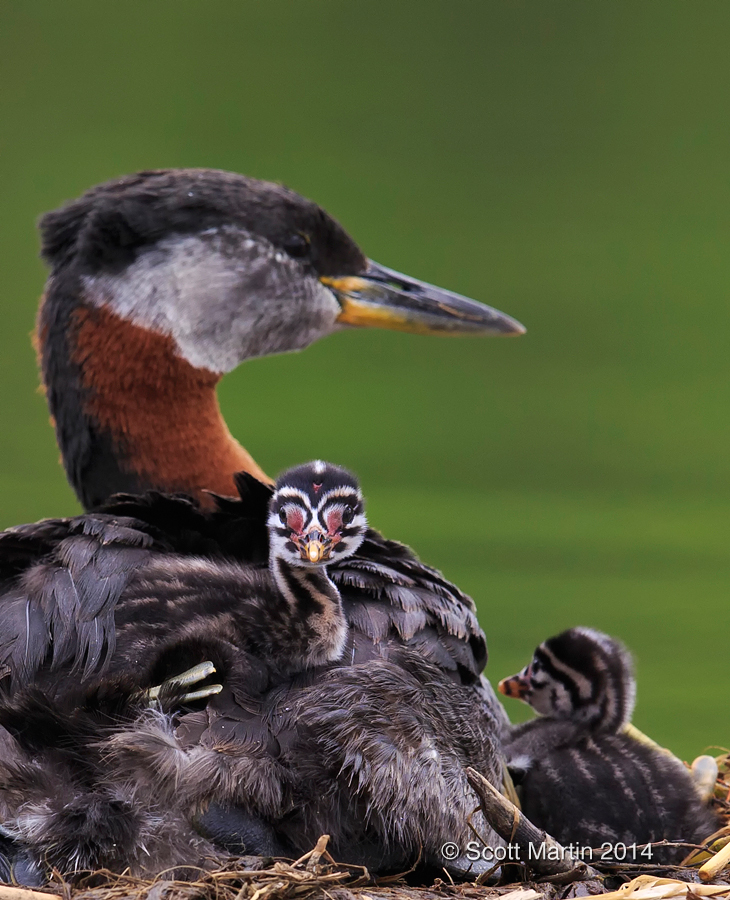
Red-necked Grebes consume mostly invertebrates including insects, molluscs, dragonflies, beetles and crayfish and they also eat fish. The Grebes also have a very peculiar item on their menu; they regularly eat their own feathers and in fact start feeding feathers to the young when they are only a few days old. The feathers remain in the stomach and tend to partially decompose into a soft amorphous mass. It is not known what the purpose of the feathers in the stomach is, although it has been suggested that they form a filter of sorts to prevent ingested bones from damaging the digestive tract.
While my good friend Arni and I were photographing the Grebes pictured in this post, we had the privilege of watching the young chicks being fed numerous times. The challenge was to get a great feeding shot with everybody looking at the approaching meal. Fortunately all four of the young cooperated at least for the split second required to get this shot. This shot is also humorous in that Dad is being overly optimistic in just how big of a fish the young ones could handle and the weight of this meal caused it to be dropped as soon as it was handed over. No problem though as the parent immediately returned with a smaller fry for the youngsters.
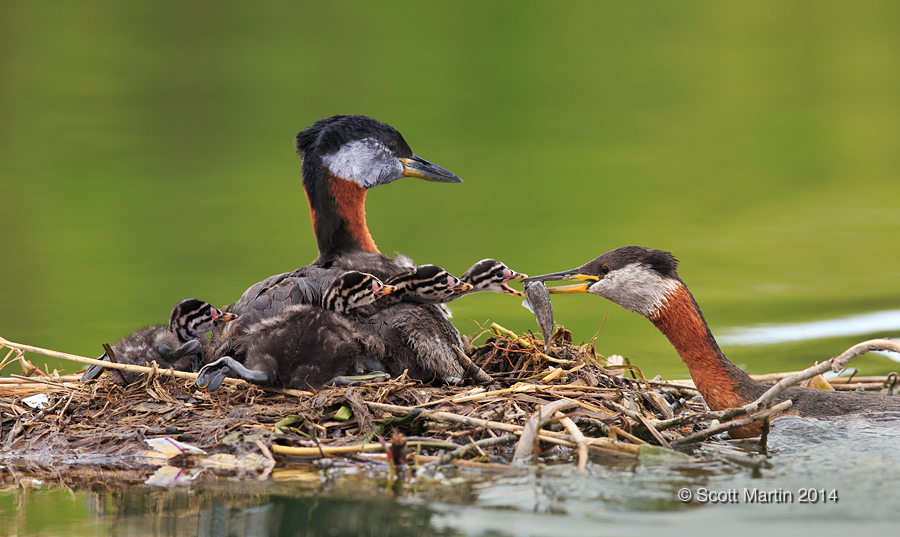
I was hopeful to photograph a Grebe chick on the back of a parent while swimming away from the nest, however this was not be. The next two images were as close as we were able to get, but that’s the beauty of bird photography, no matter how many great shots you’ve taken there is always a better one to be had next time. So we keep on looking for that ‘perfect’ yet elusive shot.
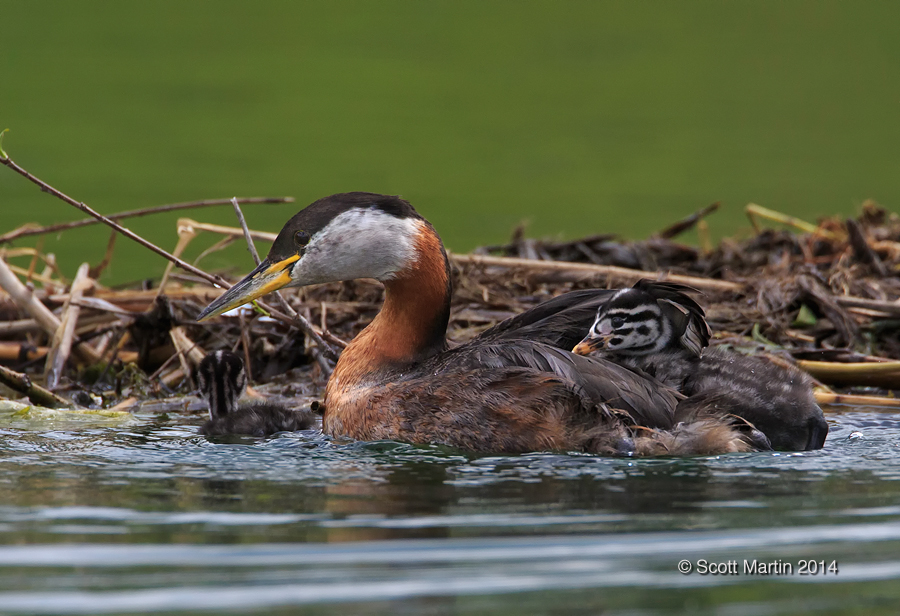
.
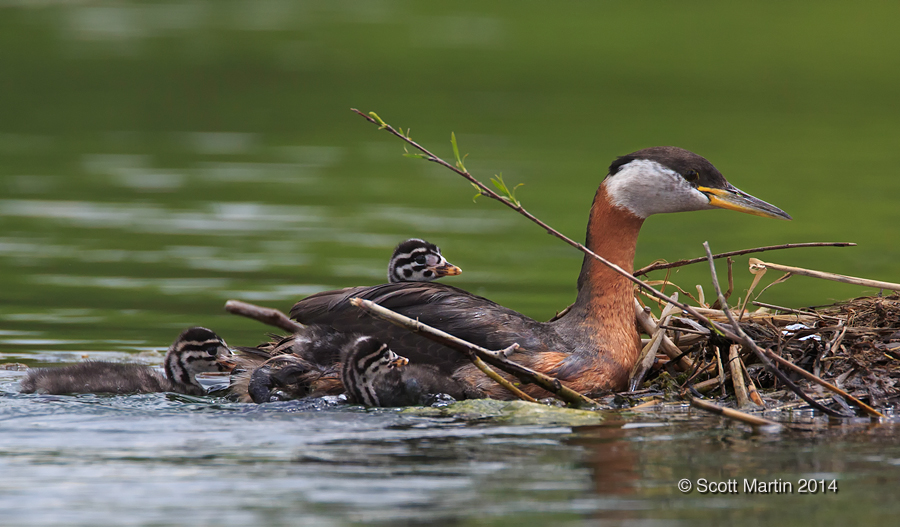
The Red-necked Grebe was an interesting bird to observe and photograph. They are also very photogenic as this concluding image demonstrates.
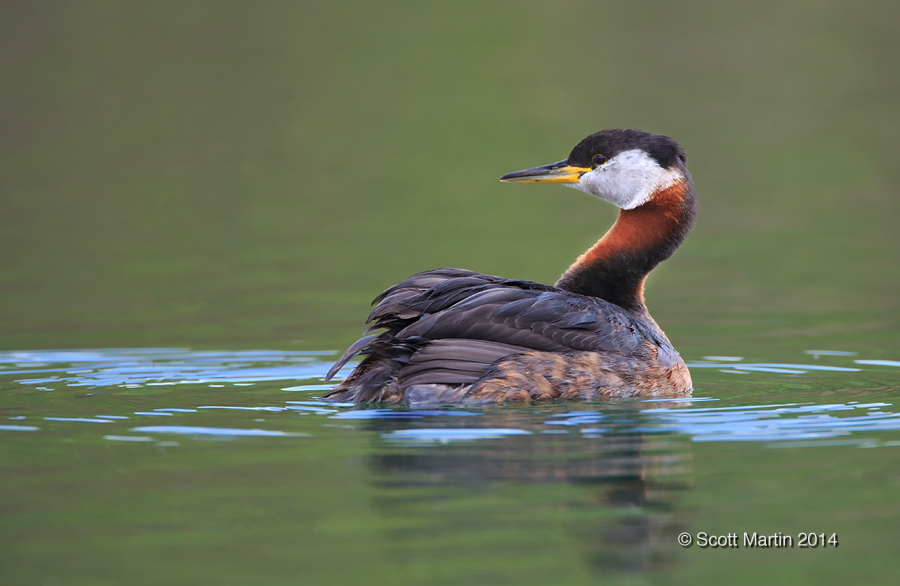
A couple of interesting facts regarding the Red-necked Grebe is that its feet are lobed rather than webbed and a group of Grebes together on the water are referred to as a ‘water dance’ of Grebes.
All of the images in today’s post were taken hand-held with a Canon 5D Mk III and EF 500 mm f4 L IS lens. Normally I use a monopod to support the weight of the lens, however as all of the images were taken while lying down to get a more desirable low angle, support for the lens was not available.
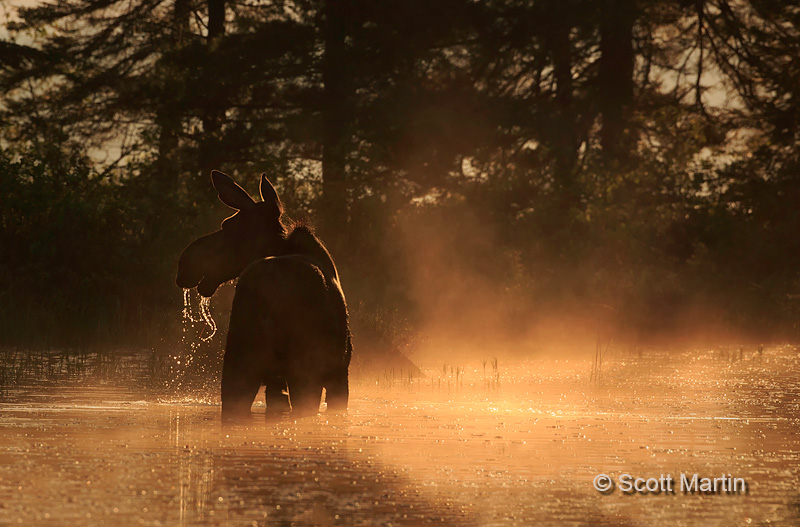
by Scott Martin Photography | Jul 14, 2013 | Birds, Blog, Educational, Loons, Wildlife
Time seems to be conspiring to pass more quickly this time of year and as a result it has been far too long since the last blog post. In order to get something posted, this will be a short blog however the hope is that it will whet your appetite for more Moose & Loons in the upcoming weeks.
Last month I had the privilege of joining my good friends Arni, Eleanor and Joyce in Algonquin Park for three days of photography, during two of which we participated in a Moose Photography Workshop with Michael Bertelsen who owns and operates Algonquin Park Photography Tours & Workshops. I had met Michael a couple of years ago at Hall’s Road in Ajax, Ontario where we were photographing birds and it was a pleasure to catch up with him again. Michael has been conducting tours in Algonquin Park for some fifteen years now and his familiarity with the park and expertise and knowledge of Moose was indispensable, not to mention his customized ‘photography boat’ which featured four swivel chairs and lots of room to shoot from any direction while on the boat. We left the dock at 5:00 a.m. and headed for an 18km ride to where the Moose could be found…..and Moose we found; about twenty of them over the two days!
The purpose of this blog is not to show all the best Moose images (that will come) but rather just a couple that were taken very near sunrise. The importance of being ‘on location’ before the sun rises can not be over estimated. There are a scant few moments while the sun peeks above the horizon that provide photographic opportunities like none other. It is also a time you can shoot into the sun and achieve interesting effects with back and rim lighting.
This first image is a good example of the rim lighting effect possible when shooting into the early morning sun.

Although compositionally you may wish the Moose was on the other side of the frame so she was looking into the frame rather than out of it; the mist coming off the water, the rim lighting around the head and through the water drops makes for a good image. From a technical perspective, it is important to underexpose the exposure suggested by your camera’s light meter when shooting into the sun. If you don’t, the camera will expose for the predominantly dark scene resulting in over exposure of the light areas which would destroy the rim effect and blow out the detail in the lighter parts of the scene (in this case the water drops and the mist). If memory serves me well, this shot was taken at two stops less than what the meter was suggesting.
The next image is what we often refer to as an environmental shot, meaning that although the Moose is the object within the image, it shows the Moose in its natural environment which is always important, and nice, to see. Unfortunately, my tendency is to dwell so much on the object of the photo shoot that I completely forget about the environment and consequently come home with many gigs of images that all look the same, with the object filling the full frame. Often environmental images make for the highest visual impact and therefore become the best images from an outing.
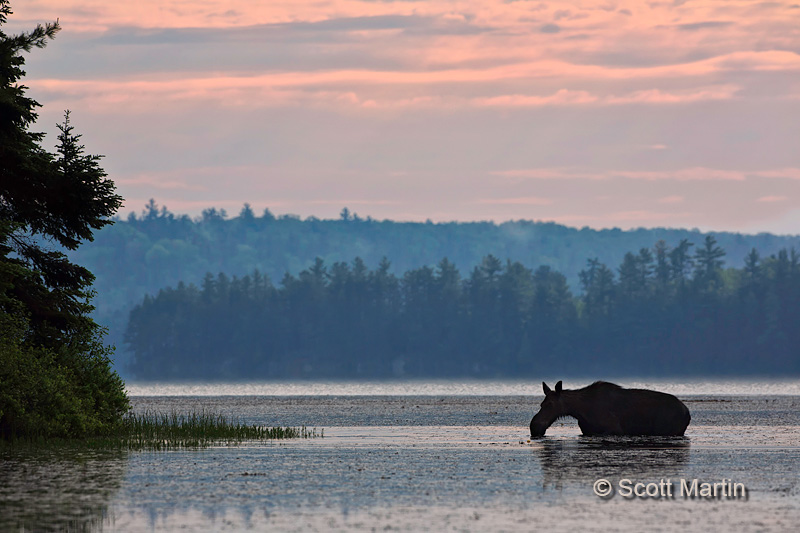
As the sun moves higher into the sky through the morning hours, the light becomes more intense and harsh, which is why most photographers do not go out after mid-morning or before mid-afternoon. Shooting into the sun becomes much more difficult to do effectively as the light intensity fluctuation between the lights and the shadows becomes extreme. This past Friday morning my wife and I were canoeing in Algonquin Park and photographing Common Loons. While were just finishing up for the morning with a pair of Loons, Deb heard the unmistakable sound of a Loon taking off. Fortunately it was heading in our direction but unfortunately we were looking almost directly into the sun. I quickly grabbed my other camera body with a longer lens and was able to get a couple of unexpected frames as the Loon completed its long take off and flew right beside us on its way to a better fishing location.
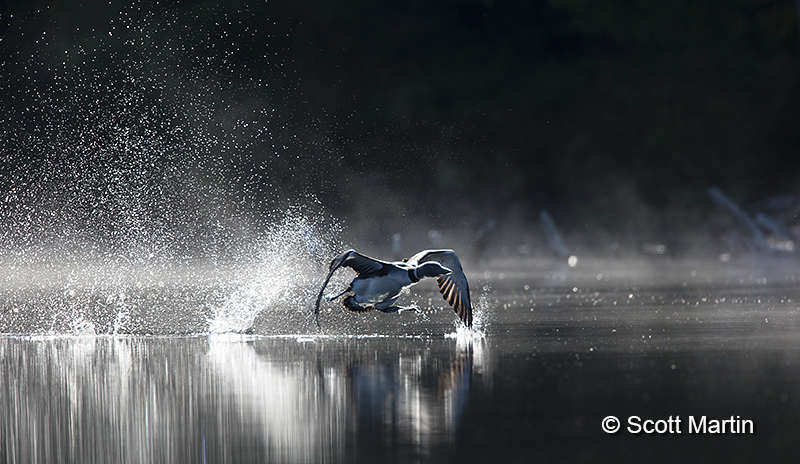
You can see how much harsher the light becomes later in the morning, in this case around 8:00 a.m. For this sequence, I exposed three or more stops less than what the meter was suggesting. It was a treat to be so close to an in flight Loon as it passed by our canoe. This next image is a little off level, however if it was leveled some of the reflection of the Loon would be lost and I felt it was more important to include as much of the reflection as possible at the expense of a level horizon!
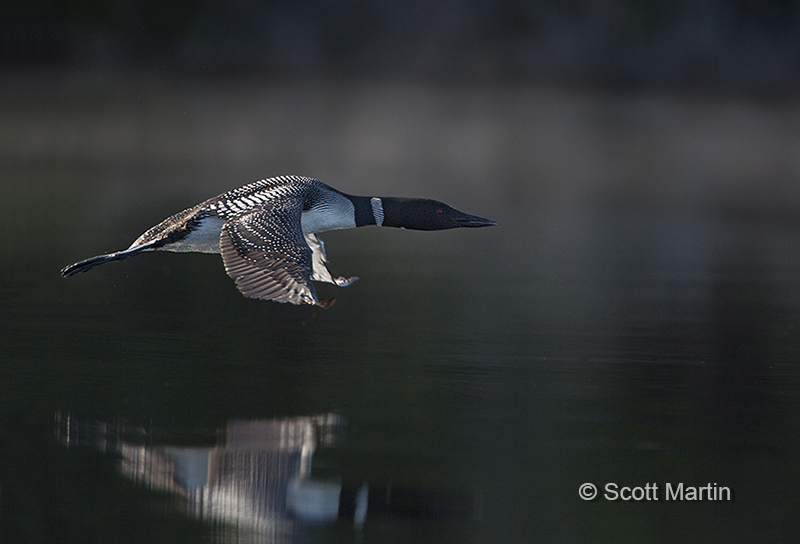
The interesting thing about all four images posted today is that were all taken from the water, which means a little more planning is required to make it all happen, but the results are well worth the effort.
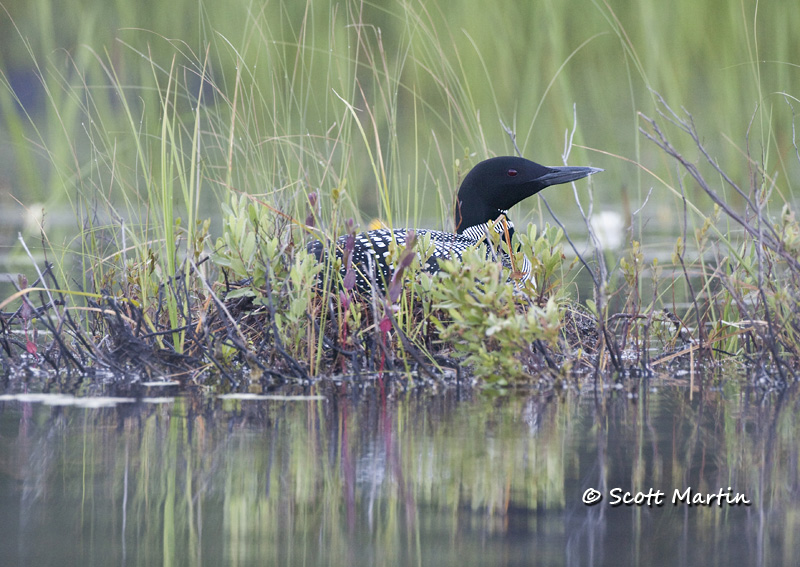
by Scott Martin Photography | Jul 10, 2012 | Birds, Blog, Loons
Over the past few years Deb and I have spent many early weekend mornings in June travelling about sixty kilometres from the cottage to Algonquin Provincial Park and then paddling a couple of kilometres in order to observe and photograph the Common Loon. June is typically the month that Loons are nesting and for the first few days after the chicks are born they spend a lot of time on their parent’s back providing a very desirable photo opportunity.
Loons are an amazing bird God designed to live on the water. They have solid bones and legs that are positioned far back on their bodies allowing them to dive and swim underwater with incredible speed and agility at recorded depths of more than 120 feet. Their design is so tailored to water that they are quite dysfunctional on land where they can only move around by a hopping and pushing themselves on their chest. They are unable to achieve flight from the ground and are only on land while nesting for the 26-31 day incubation period before their eggs hatch. Both parents share in the incubation responsibilities. Loons build their nests on the water’s edge so that they can gain access to it direct fly from the water and the young chicks can easily transition to the water; which they do the day they are born, never to return to the nest. Below is a typical nest located on a small ‘island’ not much bigger than the nest, located about twenty feet from shore and creating an important barrier to protect against predators.

As the Loon chicks move onto the water within hours of their birth, their small size and lack of development requires that they spend much time on a parent’s back for the first week of life. This allows them to rest and keep warm. They also float around on the water, always within a few feet of one of the parents. The parents keep within sight of each other and attend to the young by bringing small fry to them on a seemingly systematic schedule.
They are a pleasure to watch, and the effort required to see Loons up close is always worth it.
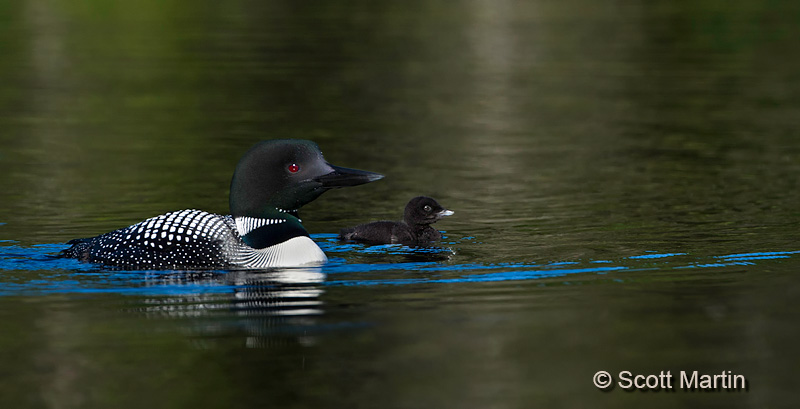
.
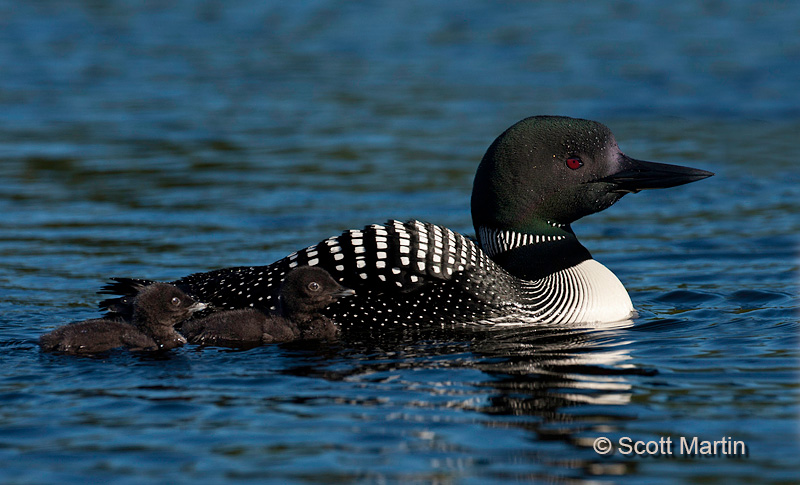
.
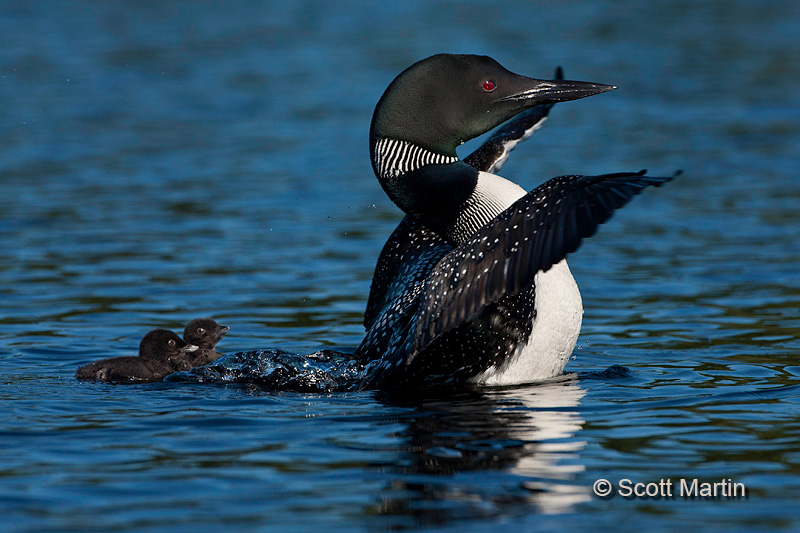
Watching the young chicks get fed is the prefect time to see the special bond between parent and offspring.
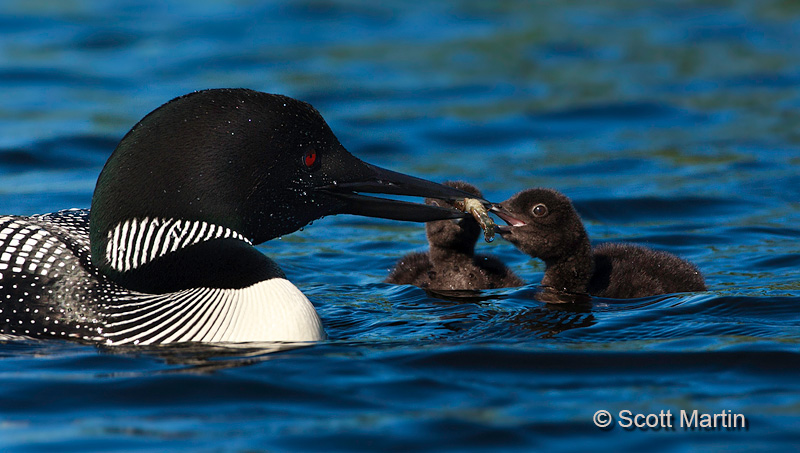
.
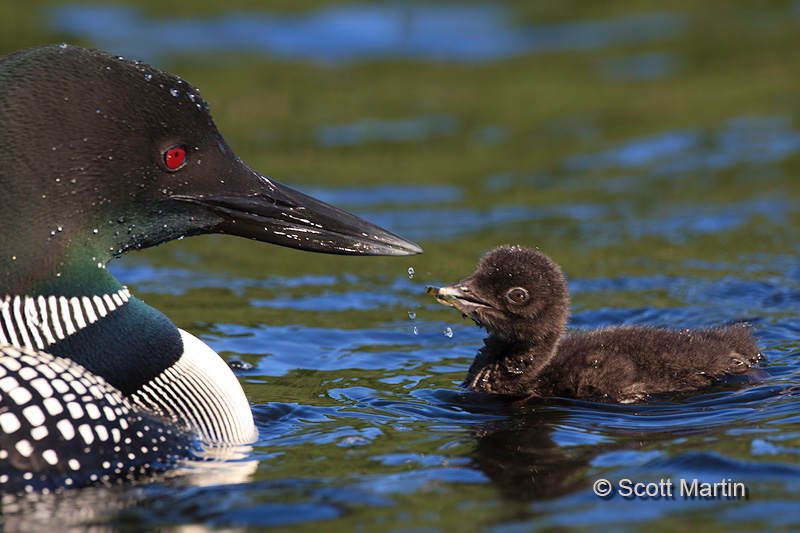
.
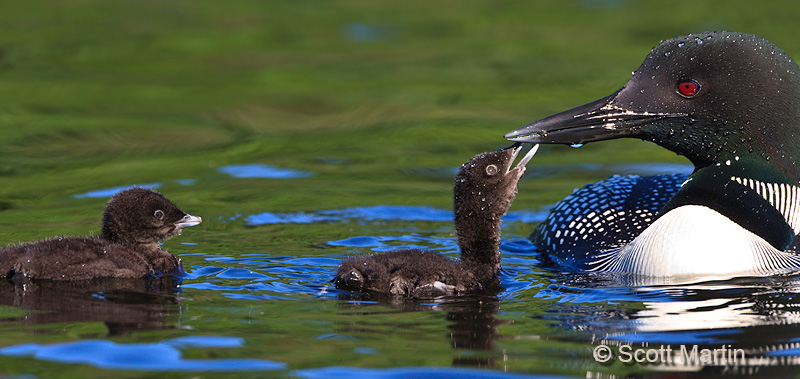
.

.
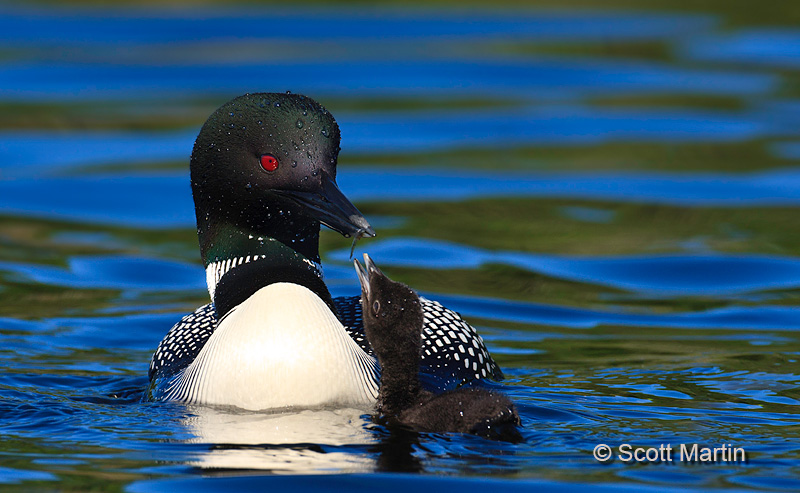
.
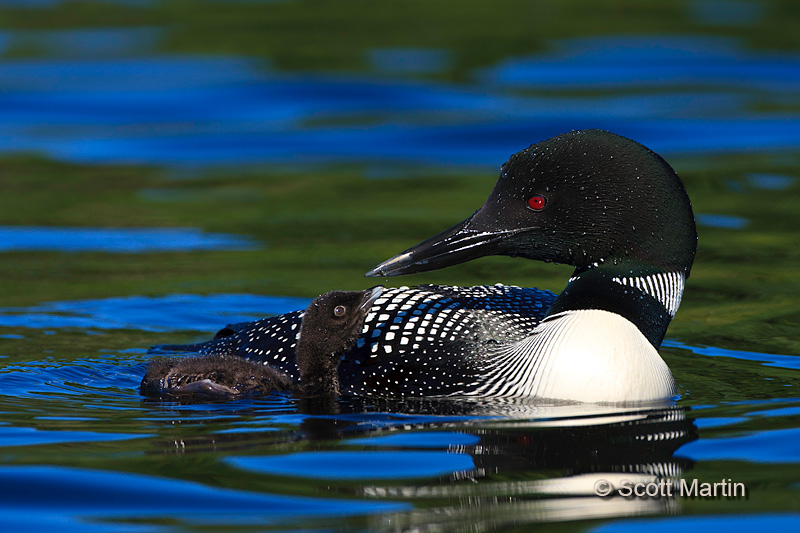
To see the chicks resting on a parent’s back and being sheltered, warmed and protected under a wing was something we’d been hoping to see for the past number of years so the following images are among our all time favourites.
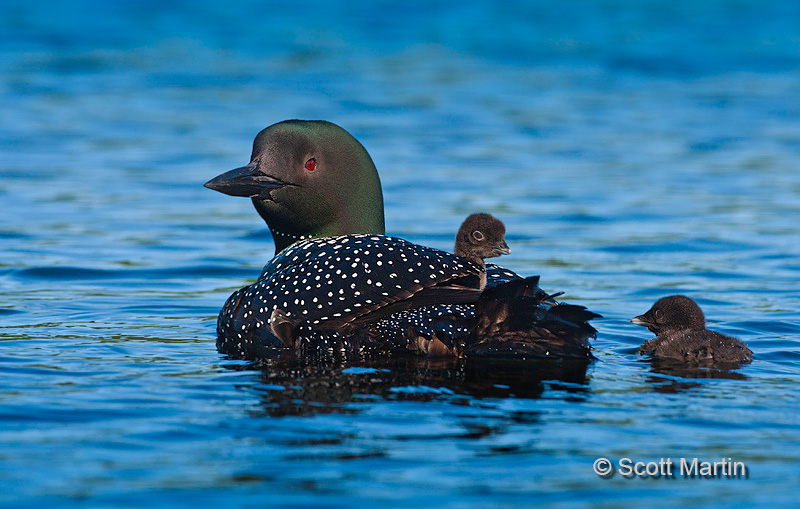
.
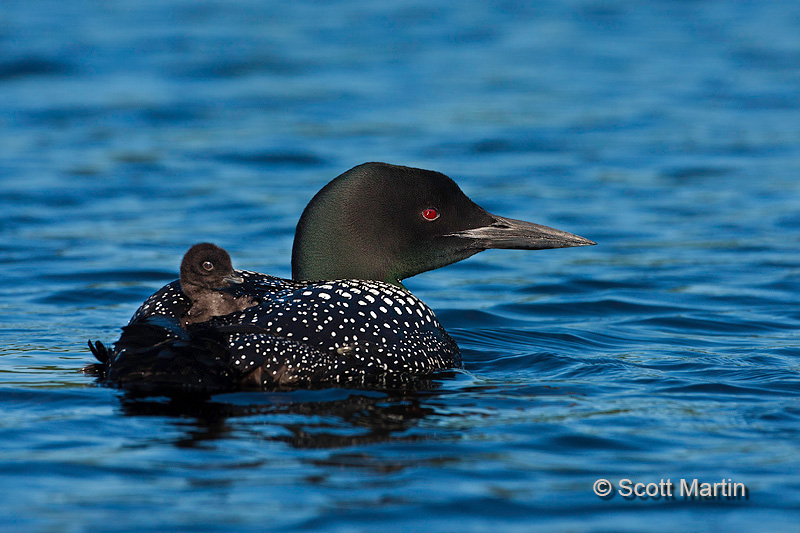
One of the chicks launching off mom’s back.
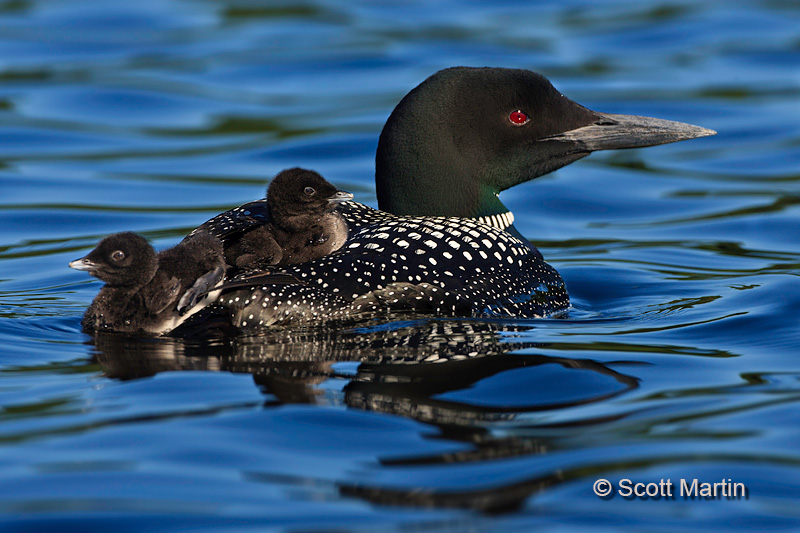
.
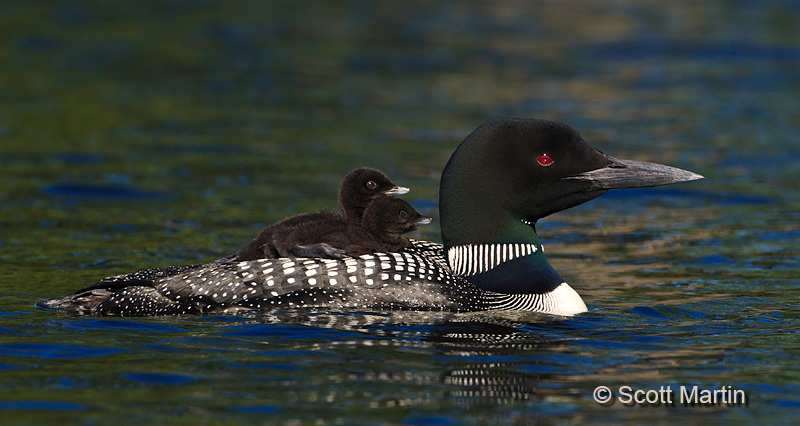
.
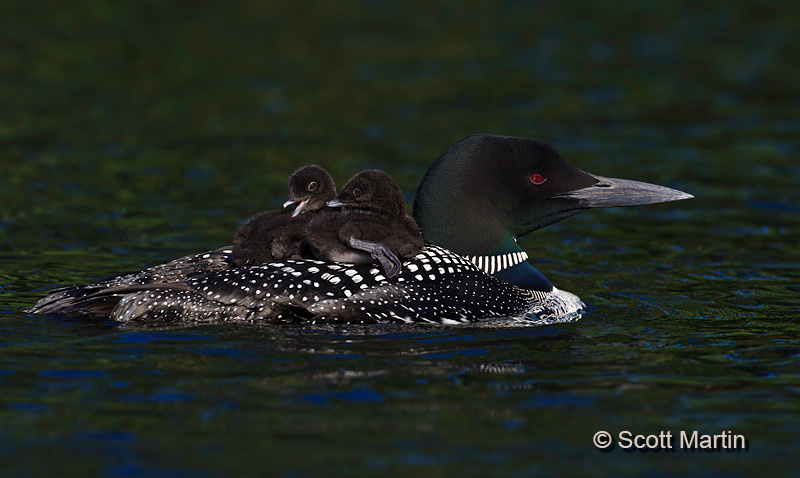
.
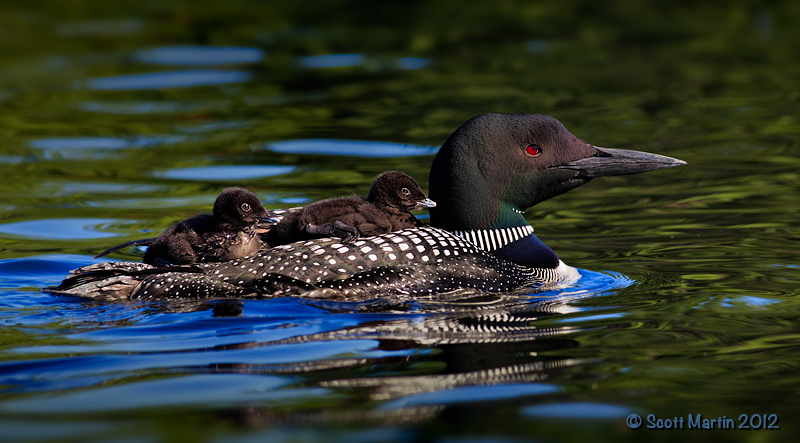
“Hey some day you will be able to do this too”!
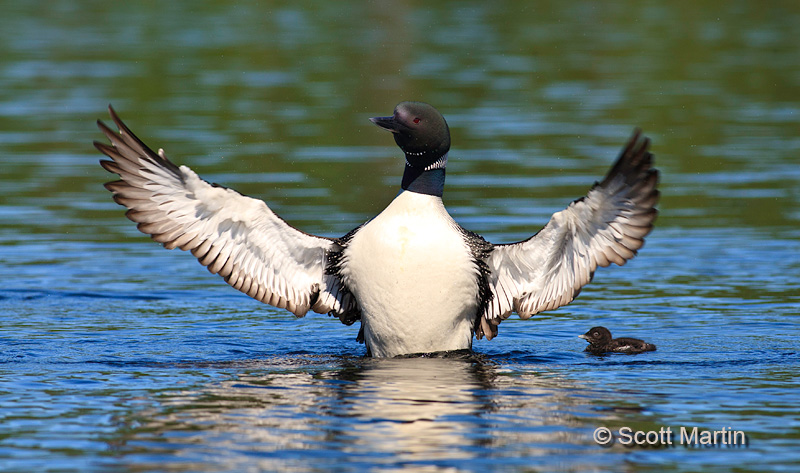
Family shot.
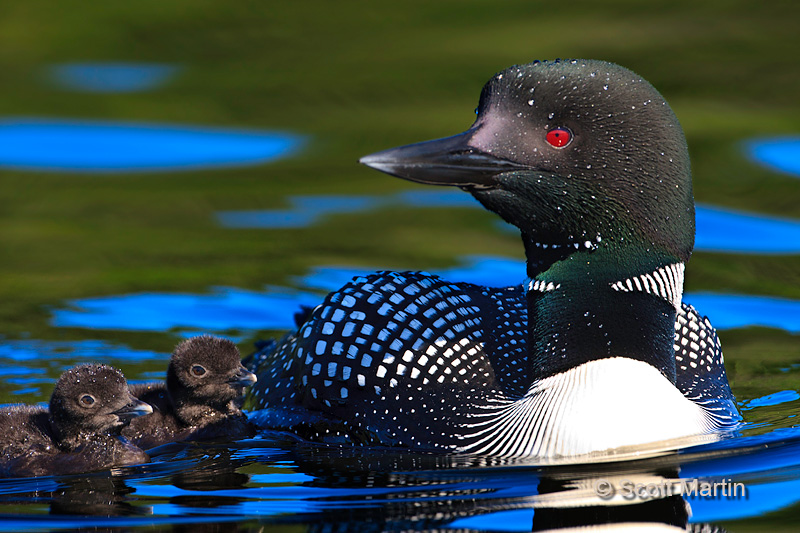
Although it’s a bit precarious taking lots of expensive camera gear in a canoe and quite a challenge to photograph from one, there are not many other ways to get close to Loons. All the images in this post were taken hand-held from a canoe with either a Canon 1D MK III & EF 500mm f4 L IS lens or a Canon 5D MK III and EF 400mm f5.6 L lens. I must thank Deb for single-handedly paddling and positioning the canoe so that the light was always right as we followed these Loons for about three hours. We are a great team but she does all of the work while I snap pictures!
If interested, more images can be seen in the Loons & Grebes Gallery
Please take the time to leave a comment as they are always appreciated and if you have any questions please don’t hesitate to ask.

by Scott Martin Photography | Aug 31, 2010 | Birds, Blog, Loons
It was a pleasure for Deb & me to spend a lot of time photographing the Common Loons in Algonquin Park this summer and I hope you have enjoyed them. In the next month or so the Loons which are normally very territorial begin to congregate in the Algonquin Lakes in preparation for their annual southern migration, which is generally completed by November. The males normally leave earlier than the females & juveniles (as it is with Hummingbirds too) presumably because the juveniles need more time to grow & mature prior to migration.
These last images feature water drops which are always fun to photograph. I’m already looking forward to next years ‘Loon Season’.
All images taken with a Canon 1D MkIII and 500 f/4 Lens, hand held from a canoe.
…and a solitary drop for the last image.

by Scott Martin Photography | Aug 26, 2010 | Birds, Blog, Loons
Only the male Loon yodels, and the yodel is his territorial vocalization. Apparently each male yodel is distinct and can be used like an audible fingerprint. To yodel the Loon fully extends its neck and enlarges the throat in order to create a type of percussion chamber. It then presses and moves its tongue into the roof of the beak to help make the pitch changes during the yodel. It is thought that as the Loons grow in size their yodel pitch lowers as the throat volume increases. During one of the many hours Deb & I spent in a canoe with Loons this summer, we observed a new male fly in and land in the area of the pair we were watching (presumably to fish). This immediately caused the resident male to head towards the ‘intruder’ and start yodeling. The visitor left as quickly as he came and headed off elsewhere to fish. Here is a shot of the yodeling male taken as he passed by our canoe. Its amazing how loud the yodel is from 30′.



















































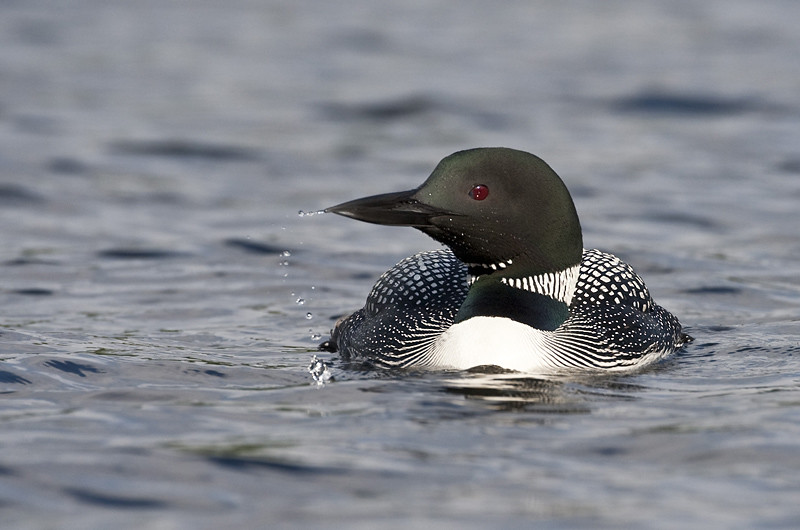

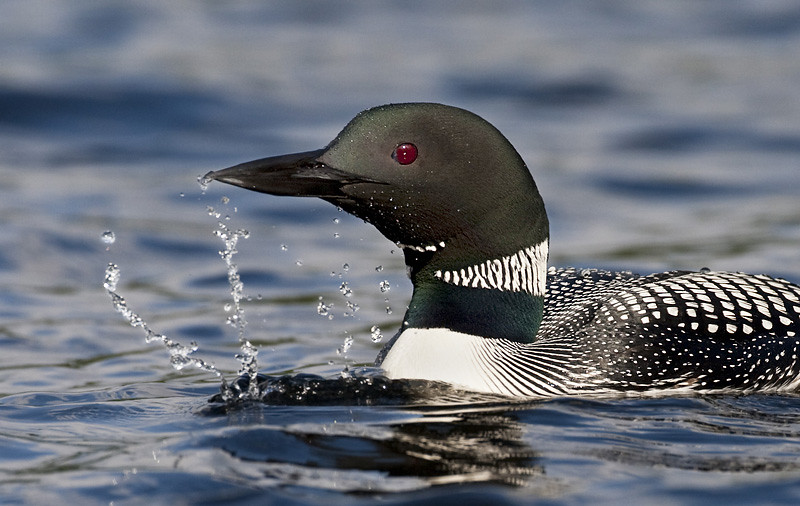



Follow Scott Martin Photography